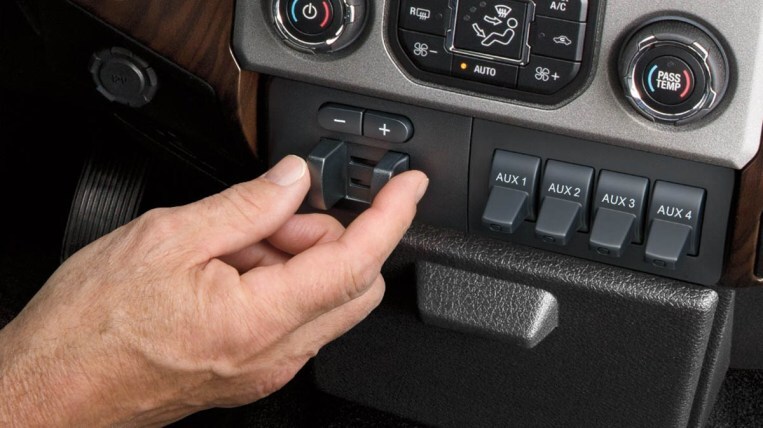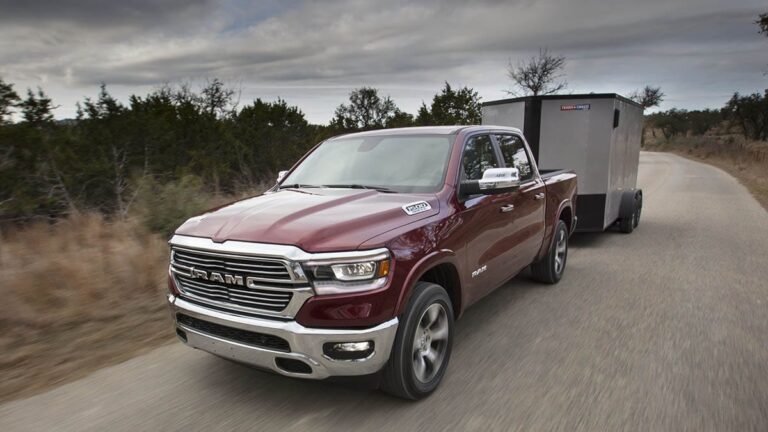Electric Trailer Brake Controller Basic Facts
- Electric trailer brakes don’t work without a brake controller
- There are two types of electric trailer brake controllers
- Government regulations require electric brakes on loads of 4,000 pounds or more
- Aftermarket trailer brake controllers are readily available
Although most of us will never tow anything, for those who do, an electric trailer brake controller is an invaluable tool for safe, efficient towing. The heavier the towed load, the more critical the trailer brake controller becomes.
If you own a newer full-size pickup truck or larger SUV, it likely has a trailer brake controller (TBC) as standard equipment. It’s integrated somewhere into the dashboard, and you might have wondered what it is and how trailer brake controllers work.
While many tow-capable vehicles come from the factory with the feature, aftermarket add-ons are plentiful because they are crucial when towing and demand is high. But, more about aftermarket trailer brake controllers later.
Consider this a primer on the electric trailer brake controller. We will explain what it is, how it works, and why you will never want to tow a heavy load without one.
What Is an Electronic Trailer Brake Controller?
A TBC is a device overseeing the electric brakes on a towed trailer. It is a device that works transparently to engage the trailer brakes automatically when needed. Typically, it also features a manual control allowing the driver to check and adjust the trailer brakes, and engage them manually if necessary.
In other words, with its control module within the driver’s reach inside the vehicle, the system works seamlessly to coordinate the trailer’s brakes with the tow vehicle’s brakes.
Where Is the Trailer Brake Controller?
In most newer trucks, factory-installed TBCs are to the left or right of the steering column. It’s designed so that if the driver needs to use the manual controls with one hand, the other hand can remain on the steering wheel.
RELATED ARTICLE: Towing Capacity Guide: Everything You Need to Know
A Quick Electronic Trailer Brake Controller Glossary
As we work our way through what TBCs do, how to set them up, and so on, we will employ some terms that may be unfamiliar. Let’s head off that issue by listing a few TBC terms and their definitions.
- Control toggles – Located on the TBC control module, the control toggles serve as the manual control for applying the trailer brakes. It can be a single button you engage to apply brake pressure or a pair of buttons you squeeze together.
- Gain – Also called trailer gain, it’s the amount of power a TBC applies to the trailer brakes. More force applied to the tow vehicle’s brakes should increase the gain for the trailer brakes.
- Proportional brake controller – This TBC system uses an acceleration sensor (also called an accelerometer) to measure the gravity and deceleration of the tow vehicle. The TBC then applies the appropriate amount of gain to the trailer brakes.
- Time-delay TBC – These brake controllers don’t operate as smoothly as proportional TBCs because using the tow-vehicle brakes initiates a timed reaction for applying the trailer brakes. That reaction includes preset amounts of gain delivered through the braking process.
- Wiring harness – These typically come in various configurations, allowing the trailer’s electric system to plug into and interface with the tow vehicle’s electric system. A wiring harness carries the taillight, brake light, and turn signal information to the trailer, and it also includes brake activation.
RELATED ARTICLE: Maximum Towing Capacity For Every Truck

How To Use a Trailer Brake Controller
Whether you use a proportional TBC or a time-delay TBC, activation of the trailer brakes is automatic. That is, when you apply the brakes in the tow vehicle, the trailer’s brakes also activate.
Proportional Trailer Brake Controllers
For enthusiasts who tow often or tow a variety of loads, proportional controllers are likely the better choice. Usually self-calibrating, they deliver smoother stops. However, they must be installed in a location sensitive to the proper operation of the accelerometer. The result is the trailer brakes react more quickly to match the level of tow-vehicle brake pressure.
Pros
- Quicker reaction time
- Less setup required
- Smoother braking and operation
Cons
- Additional expense
- More complicated installation
Time-Delay Trailer Brake Controllers
Although time-delay controllers are adequate in terms of safety and efficiency, they are better suited for drivers who tug lighter loads. They also perform more efficiently on flatter terrain. This is because a time-delay controller operates to preset specifications rather than matching the tow vehicle’s braking.
Moreover, during braking events, the slowing is based on preset times loaded into the TBC. Consequently, the trailer brakes may not brake at the exact same rate as the tow vehicle’s brakes. The misfire can result in a pushing-and-pulling effect, increasing wear on both the tow vehicle and the trailer.
Pros
- Function doesn’t depend on the TBC mounting location
- Easy installation
- More affordable
Cons
- Slower to respond
- Pushing-and-pulling effect
- More wear and tear on the brakes
RELATED ARTICLE: How to Know if You Need a Brake Job
How To Adjust an Electronic Trailer Brake Controller
No matter which type of TBC your tow vehicle has, you must make some adjustments when trailer loads vary. Here are seven steps to testing and adjusting a TBC.
- Park on a flat surface.
- Plug in the wiring harness.
- If required, allow the TBC to self-calibrate.
- Input the trailer gain setting. It will usually display as a number from 0-10 with increasing increments of 0.5. (Some will show settings of 10-100 with increments of 5.) The higher the number, the greater the braking power (gain). For a lighter load, begin with a 2 (or 20) setting. Start the tow vehicle, squeeze the manual control toggle(s) and release the brake. If the tow vehicle starts moving, the gain is too low. Raise the setting to 4 (40) and repeat the process. When you reach the proper gain for the load, the trailer brakes will hold the tow vehicle in place with the control toggles squeezed and the foot brake released.
- Test the brakes by accelerating to about 25 miles per hour before applying the brakes. If you don’t feel a sufficient braking force, increase the gain and try again. If there is too much gain, reduce it and try again.
- Set the brake sensitivity. Somewhat like the gain, sensitivity determines how aggressively the TBC applies the trailer brakes. It is a separate control from the gain, but you test it in the same way. Accelerate to 25 mph and depress the brake pedal. If braking is too slow, adjust the sensitivity to a higher setting. Conversely, adjust the sensitivity lower if the braking is too abrupt.
- Repeat this exercise every time you increase or decrease the towing load.
Aftermarket Electronic Trailer Brake Controllers
The odds are decent that if you have a large tow vehicle less than five years old, it has a factory-installed TBC. However, that’s not always the case. Moreover, most drivers never pull anything; therefore, many buyers wouldn’t shoulder the extra expense if the TBC was an added-cost option. So, for the sake of argument, let’s say your tow vehicle doesn’t have a TBC.
The good news is the aftermarket is loaded with choices. Ranging in price from $40 to $300, both time-delay and proportional TBC units are readily available. If your intent is serious towing in various terrain, we recommend a proportional TBC, pushing the price into the $150-plus range. It will also somewhat complicate the installation.
Although we usually recommend that professionals do any installation involving a vehicle’s electric system, adding a TBC to your truck or SUV is a relatively simple install. If you are a DIYer to any degree, you can probably knock out the installation in a couple of hours.
Read Related Articles:


